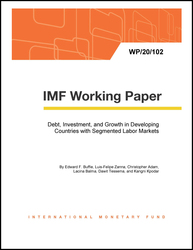
Debt, Investment, and Growth in Developing Countries with Segmented Labor Markets
Debt, Investment, and Growth in Developing Countries with Segmented Labor Markets
READ MORE...
Volume/Issue:
Volume 2020
Issue 102
Publication date: June 2020
ISBN: 9781513545639
$18.00
Add to Cart by clicking price of the language and format you'd like to purchase
Available Languages and Formats
| English |
Prices in red indicate formats that are not yet available but are forthcoming.
Topics covered in this book
This title contains information about the following subjects.
Click on a subject if you would like to see other titles with the same subjects.
Labor , Economics- Macroeconomics , WP , math display , Public Investment , Growth , Debt , Fiscal Policy , Human Capital , Labor Markets , Welfare , real wage , private sector , unemployment rate , minimum wage , involuntary unemployment , depreciation rate , discount rate , wage premium , Wages , Infrastructure , Sub-Saharan Africa , Africa , wage differential , internal rate of return , diminishing returns , investment program
Summary
We introduce a new suite of macroeconomic models that extend and complement the Debt, Investment, and Growth (DIG) model widely used at the IMF since 2012. The new DIG-Labor models feature segmented labor markets, efficiency wages and open unemployment, and an informal non-agricultural sector. These features allow for a deeper examination of macroeconomic and fiscal policy programs and their impact on labor market outcomes, inequality, and poverty. The paper illustrates the model's properties by analyzing the growth, debt, and distributional consequences of big-push public investment programs with different mixes of investment in human capital and infrastructure. We show that investment in human capital is much more effective than investment in infrastructure in promoting long-run economic development when investments earn their average estimated returns. The decision about how much to invest in human capital versus infrastructure involves, however, an acute intertemporal trade-off. Because investment in education affects labor productivity with a long lag, it takes 15+ years before net national income, the private capital stock, real wages for the poor, and formal sector employment surpass their counterparts in a program that invests mainly in infrastructure. The ranking of alternative investment programs depends on the policymakers' social discount rate and on the weight of distributional objectives in the social welfare function.
Copyright © 2010 - 2024
Powered by:
AIDC



